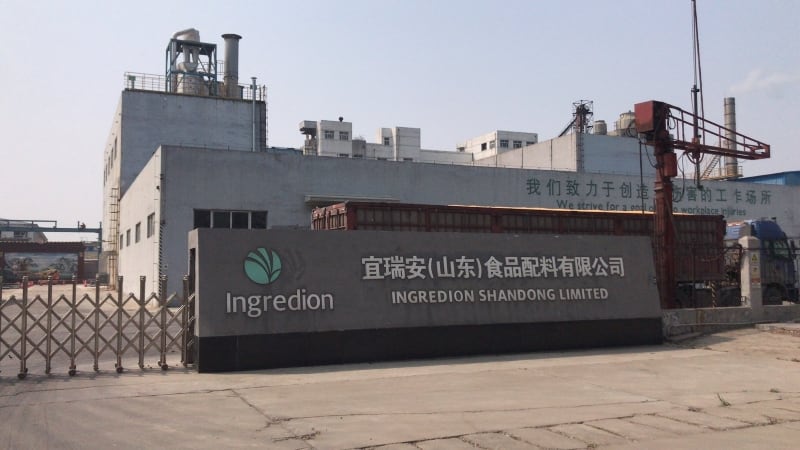We chatted with Atiyya Tailor, brand manager at European Freeze Dry, about a study that says adding freeze dried fruit powder can slow ice cream melting, we also had a conversation with Martin Easter, chief scientific officer at Hygiena, which has launched the InSite L. mono Glo Environmental Surface Screening Test for Listeria, and we talked to Eric Weisser, innovation director, Ingredion Asia-Pacific and Valdirene Licht, senior vice president and president, Ingredion Asia-Pacific, from Ingredion about their starch facility expansion in China.
We also have our weekly look at the global dairy markets with Charlie Hyland from INTL FCStone.
Hygiena launches all-in-one Listeria detection method
California-headquartered Hygiena, which provides solutions in rapid microbial detection, monitoring, and identification technology, has launched the InSite L. mono Glo Environmental Surface Screening Test.

InSite L. mono Glo is an easy-to-use, self-contained, environmental sampling and screening test for Listeria species including Listeria monocytogenes (L. mono).
Each device contains liquid media containing antibiotics, growth enhancers, and color-changing compounds specific to Listeria, plus fluorescent compounds specific to Listeria monocytogenes.
Within 48 hours, the two-step test changes color in the presence of Listeria species, while illumination with UV light reveals L. monocytogenes, if present. The test is used for environmental monitoring in food processing facilities after cleaning. Screening out negative samples quickly and easily provides a cost-effective way to increase surveillance, monitor hazards and control risks.
The InSite L. mono Glo test was certified under the AOAC-RI Performance Tested Method in late 2018 (certification number 061802). The certification verifies the claims that the test detects low levels of Listeria spp. and L. monocytogenes on stainless steel, ceramic and plastic surfaces.
The Insite L. mono Glo method requires no complex laboratory equipment, and is self-contained, which reduces the risks of sample cross-contamination. As government regulators worldwide have made monitoring and controlling Listeria a priority, more food safety professionals are looking for convenient, cost effective methods.
Could adding freeze dried fruit powder slow ice cream melting?
Researchers have found freeze drying technology could result in tastier ice-cream that melts at a slower rate – offering food processors new opportunities according to a leading freeze-drying manufacturer.
The research, carried out by the Agricultural Research Service in the US, proved freeze-dried fruit powders including strawberries, blackberries and raspberries improved the taste and structure of ice-cream and other frozen desserts.
Freeze dried fruit powders provide a raw fruit alternative to traditional stabilizers such as xanthan gum or sodium alginate. With a rise in consumer demand for natural ingredients driving new food markets, food processors can benefit from using raw ingredients in sweet products, according to Diana Morris, Country Manager UK from European Freeze Dry.
She said, “This research allows ice-cream producers and makers to revisit the stabilisers that they use in their products and move to a raw fruit alternative that is more attractive to consumers.
“While different varieties of fruit powders were tested as part of the research, strawberry powder was found to be the most effective as a stabilizer, with raspberry powder also having a positive effect.”
The powders, which are created by a freeze-drying process that removes all water content, absorb the liquid from the ice cream as it rises in temperature, which rehydrates the powder rather than causing the product to melt. The powders also reduce the formation of ice-crystals during the ice-cream making process, while giving the product a creamier taste.
The research added 3.5% of freeze-dried strawberry, raspberry, blackberry and blueberry powder to ice cream. This equated to roughly 20g of powder per liter of ice cream. Strawberry powder was found to act as the most effective stabilizer, completely preventing melt-down, followed by raspberry and blackberry. Blueberry powder was found to have a minimal effect.
At European Freeze Dry, all products for freeze drying start as frozen raw materials, and undergo sublimation under specifically designed programs.
During the freeze-drying process a deep vacuum is applied, and under these conditions neither ice or water can exist. The pressure from the vacuum, with a controlled amount of heat applied, causes the ice to leave the product as a vapour trail which is then captured on an ice condenser within the freeze drier, upon which the vapour forms again as ice.
The process takes on average a day to complete, carried out in a set of ‘chambers’ which can be controlled at various temperatures and time schedules depending on specific product requirements.
The reduction in water in the final freeze-dried product means there is a much-reduced potential for microorganisms existing in such low amounts of water, leading to a shelf life of up to two years at room temperature.
Ingredion to build new Chinese facility to double capacity
Ingredion Incorporated, a global provider of ingredient solutions, has announced it will expand its production capacity and capabilities in Shandong, China.
With this investment, the company will build a new, integrated native and modified starch facility adjacent to its existing Shandong facility. The expanded capabilities will provide additional service and supply benefits for its local and regional customers while further optimizing its global supply chain network for specialty starches. The investment is expected to be complete by early 2022.

“We see strong demand for clean-label ingredients and specialty starches coming from our established and emerging food customers,” said Valdirene Licht, senior vice president and president, Asia-Pacific.
“Chinese consumers are seeking healthier, more diverse, premium and convenient food options. This investment enables us to further strengthen partnerships with our customers as a well-positioned local supplier. Ingredion’s local market insights, concept-to-launch expertise and technical and sales services will enable us to deliver consumer-preferred innovation on behalf of our customers.”
The new Ingredion Shandong facility complements the company’s manufacturing network in Shanghai and is strategically located next to local farmers who provide high-quality raw materials, such as non-GMO corn.
“This facility not only provides us with faster access to raw materials, it also allows us to effectively implement our sustainable agriculture program benefiting local farmers. We can produce high quality and diverse products that our customers require to meet the local market trends,” said Jacques Guglielmi, vice president and general manager, Greater China.



